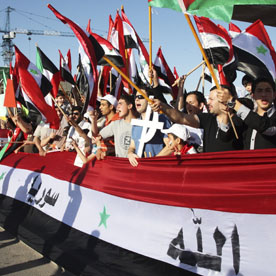Tortured 13-year-old a symbol for Syrian resistance
Anti-government protesters in Syria renew efforts as footage emerges of the mutilated body of a 13-year old-boy. Human Rights Watch say the abuses amount to “crimes against humanity”.
Despite the brutal crackdown by Syria‘s security forces on protesters, the opposition movement says it has gained momentum after the death of 13-year-old Hamza al-Khatib, who was tortured and abducted by the country’s security forces.
Hamza went missing after a demonstration at army barracks near Deraa at the end of April. Activists say he was captured and tortured to death and that his mutilated body was handed back to his family four weeks later.
The government says he received three fatal gunshot wounds during the protest and died on the spot. In a video posted online, apparent medical examiners point to gunshot wounds on his partly decomposed body.
They also refer to Hamza’s broken neck, heavy bruising on his arms and legs, and evidence of torture and mutiliation. They also say his genitals were cut off.
US Secretary of State Hillary Clinton condemned the killing and said she hoped the death would persuade Syria to begin a transition to real democracy.
Australian Foreign Minister Kevin Rudd said such incidents had robbed President Assad of any legitimacy and urged the the UN Security Council to refer him to the International Criminal Court.

‘Crimes against humanity’
A Human Rights Watch report, based on the testimony of more than 50 victims and witnesses, says abuses in Deraa have been widespread,
It details “systematic killings, beatings, torture using electroshock devices, and detention of people seeking medical care.”
“For more than two months now, Syrian security forces have been killing and torturing their own people with complete impunity,” said Sarah Leah Whitson, Middle East director at Human Rights Watch.
“They need to stop – and if they don’t, it is the Security Council’s responsibility to make sure that the people responsible face justice.”
More than 1,000 civilians have been killed by security forces and 10,000 detained since demonstrations first erupted in mid-March, according to human rights groups.
The protests first broke out in Deraa in response to the detention and torture of 15 children accused of painting graffiti slogans calling for the government’s downfall.
Human Rights Watch’s evidence stated “security forces have repeatedly and systematically opened fire on overwhelmingly peaceful demonstrators.”
Some of the deadliest incidents Human Rights Watch documented include:
- An attack on al-Omari mosque, which served as a rallying point for protesters and a makeshift hospital for the wounded protesters, and attacks on ensuing protests from March 23 to 25, killing more than 30 protesters;
- Attacks on demonstrators during two protests on April 8, resulting in at least 25 deaths;Attacks during a protest and a funeral procession in the town of Izraa on April 22 and 23, resulting in at least 34 deaths; and
- Killings during the blockade of Deraa and neighboring villages beginning on April 25, and during an effort by residents of neighboring towns to break the siege on April 29, which left up to 200 dead.
Rastan
Meanwhile in Rastan, it’s emerged Syrian forces killed 41 civilians in the central town of Rastan on Tuesday during a military operation to crush pro-democracy protests, according to human rights lawyer Razan Zaitouna.
The death toll included a four year old girl, Zaitouna told Reuters by telephone from Damascus. Government forces surrounded the town on Sunday and shelled it during the Tuesday operation, she said, adding that activists on the ground had a list consisting of 41 dead civilians.
Five of them were buried in Rastan on Wednesday.